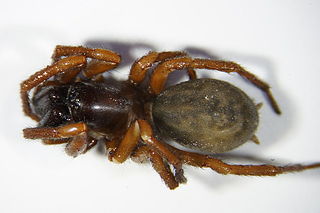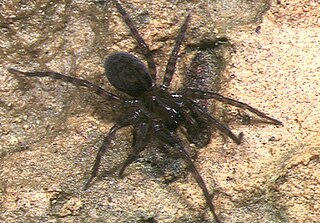
The Trionychidae are a taxonomic family of a number of turtle genera, commonly known as softshell turtles. The family was erected by Leopold Fitzinger in 1826. Softshells include some of the world's largest freshwater turtles, though many can adapt to living in highly brackish areas. Members of this family occur in Africa, Asia, and North America, with extinct species known from Australia. Most species have traditionally been included in the genus Trionyx, but the vast majority have since been moved to other genera. Among these are the North American Apalone softshells that were placed in Trionyx until 1987.

Salamandridae is a family of salamanders consisting of true salamanders and newts. Salamandrids are distinguished from other salamanders by the lack of rib or costal grooves along the sides of their bodies and by their rough skin. Their skin is very granular because of the number of poison glands. They also lack nasolabial grooves. Most species of Salamandridae have moveable eyelids but lack lacrimal glands.

Takanori Nishikawa is a Japanese musician, singer, songwriter, record producer, actor, voice actor, radio personality, and businessman. He performs under the stage name T.M.Revolution (T.M.R.), which stands for "Takanori Makes Revolution", stemming from the famous 1980s pop electronic band TM Network. Despite most of his songs being written by Akio Inoue and composed/arranged by Daisuke Asakura, T.M.Revolution is considered Nishikawa's solo project. Nishikawa is also known for contributions of ending and opening themes to many notable anime and game series.

The Asiatic salamanders are primitive salamanders found all over Asia, and in European Russia. They are closely related to the giant salamanders, with which they form the suborder Cryptobranchoidea. About half of hynobiids currently described are endemic to Japan.

The Agelenidae are a large family of spiders in the suborder Araneomorphae. Well-known examples include the common "grass spiders" of the genus Agelenopsis. Nearly all Agelenidae are harmless to humans, but the bite of the hobo spider may be medically significant, and some evidence suggests it might cause necrotic lesions, but the matter remains subject to debate. The most widely accepted common name for members of the family is funnel weaver.
Miwa Nishikawa is a Japanese director and screenwriter. Nishikawa received a degree in literature from the University of Waseda, and after working on several independent films as well as catching the eye of Hirokazu Kore-eda, her film making career took off with her first film, Wild Berries, which won the award for best screenplay at the Mainichi Film Award. In addition to her film making career, Nishikawa has also written a book titled The Long Excuse.

Malassezia is a genus of fungi. It is the sole genus in family Malasseziaceae, which is the only family in order Malasseziales, itself the single member of class Malasseziomycetes. Malassezia species are naturally found on the skin surfaces of many animals, including humans. In occasional opportunistic infections, some species can cause hypopigmentation or hyperpigmentation on the trunk and other locations in humans. Allergy tests for these fungi are available. It is believed French revolutionary Jean-Paul Marat suffered from a fungal infection from Malassezia restricta, which lead to his frequent bathing in a medicinal substance.

Kalophrynus is a genus of microhylid frogs. It is the only genus in the subfamily Kalophryninae. The species in this genus are found in southern China, in Southeast Asia to Java and Philippines, and in Assam, India.

Tylototriton is a genus of newts known as crocodile newts or knobby newts. About 38 known species are in this genus. Many species have been described just recently. They range from northeastern India and Nepal through Burma to northern Thailand, Laos, Vietnam, and southern China.

Hynobius is a genus of salamander in the family Hynobiidae, occurring in Japan, Korea, China, Taiwan and Far East Russia.

Thalassina is a genus of mud lobsters found in the mangrove swamps of the Indian Ocean and western Pacific Ocean. Its nocturnal burrowing is important for the recycling of nutrients in the mangrove ecosystem, although it is sometimes considered a pest of fish and prawn farms.

Polyozellus is a fungal genus in the family Thelephoraceae, a grouping of mushrooms known collectively as the leathery earthfans. Previously considered a monotypic genus, it now contains the Polyozellus multiplex species complex. The genus name is derived from the Greek poly meaning many, and oz, meaning branch. It is commonly known as the blue chanterelle, the clustered blue chanterelle, or, in Alaska, the black chanterelle. The distinctive fruit body of this species comprises blue- to purple-colored clusters of vase- or spoon-shaped caps with veiny wrinkles on the undersurface that run down the length of the stem.

Coelotes is a genus of funnel weavers first described by John Blackwall in 1841. A large number of species are found throughout Europe and Asia.

Iwogumoa is a genus of Asian funnel weavers first described by Kyukichi Kishida in 1955.
Tegecoelotes is a genus of Asian funnel weavers first described by S. V. Ovtchinnikov in 1999.

Falcileptoneta is a genus of East Asian leptonetids that was first described by T. Komatsu in 1970.

Peniculus hokutoae is a species of parasitic pennellid copepod. It was described in 2018 from a single female. The type-host is the myctophid fish Symbolophorus evermanni and the type-locality is off Japan. The Japanese name of this species is hokuto-kozutsu-hijikimushi.
Troglocoelotes is a genus of east Asian funnel weavers. It was first described by B. Li, Z. Zhao and C. T. Zhang in 2019, and it has only been found in China.
Aeolocoelotes is a genus of east Asian funnel weavers. It was first described by K. Okumura in 2020, and it has only been found in Japan.
Curticoelotes is a genus of east Asian funnel weavers. It was first described by K. Okumura in 2020, and it has only been found in Japan.














